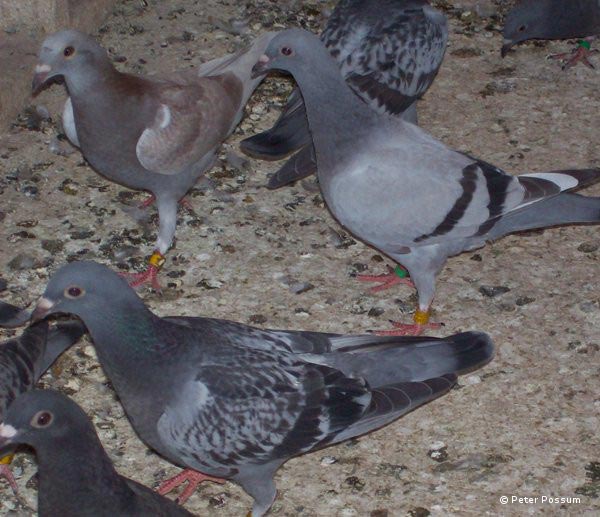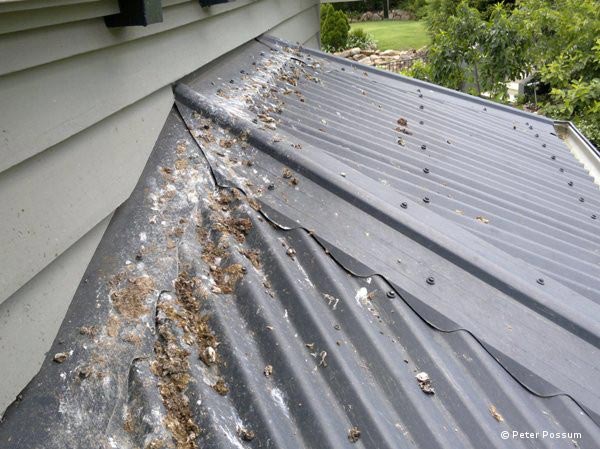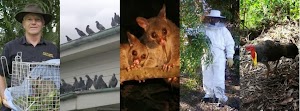1. ANIMAL DESCRIPTION
Common name: City Pigeon or Rock Pigeon or Rock Dove or Common Pigeon
Scientific name: Columba livia
SIZE AND WEIGHT
The fully grown adult is between 320 to 370 mm long. Their wingspan is approximately 640 to 720 mm. The weight of a standard Rock Dove ranges from 238 to 380 grams depending on available abundant food sources.
COAT
They generally have a dark bluish-grey head and neck plumage which runs down to its chest area. The plumage of the lower neck and chest has a shiny metallic reflective appearance with yellow and green colours. The feral pigeon also has reddish and purple iridescent sheen along its neck and wing feathers.
It is not unusual to find racing pigeons that have joined a flock of ferals because they have failed to find their way back to their owners racing loft. They may well remain with the other birds for the rest of their lives and inter-breed but can be identified by the metal band on their leg.
FEATURES
Their eyes can have an orange coloured iris with a red or golden pale inner ring. The skin around the eye tends to be a light grey to pale blue colour. The pigeon’s bill is a grey to black colour. The feet are anywhere from a purple to a reddish colour.
The slight distinguishing features between adult males and females are very subtle and they are almost identical in appearance to the untrained observer. The male will usually have more of iridescence to his neck region while the female has less intense colourations. The female’s colours are more restricted to the rear and sides of the neck and the breast colouration is often faint.
Immature adult’s show little luster to their plumage and are duller in colouration. Their eye colours are generally orange but a few younger pigeons
may have white to grey eyes before they mature. Their eyelids are also orange and are encapsulated in a greyish eye band.

Feral Pigeons
2. ECOLOGY AND BEHAVIOUR
Pigeons found in our cities are a direct descendant of the domestic pigeon which was originally kept and bred for entertainment and food. Centuries ago, the domestic pigeon was originally bred from the wild Rock Dove.
The natural habitat for their wild relatives is cliffs found along the coastline and mountainous ranges. Wild pigeons, domestic pigeons and Feral Pigeons are all the same species and will readily interbreed.
Where the wild pigeon will inhabit cliffs and mountains the feral substitutes these habitats for the ledges of urban buildings. As a result the feral pigeon has become highly evolved and adapted to urban city life amongst the built environment. They are now overly abundant in towns and cities throughout much of the modern world, so much so they have been declared an invasive species of bird.
An invasive bird species is considered a pest both environmentally and socially. The feral pigeon in particular has been found to have highly acidic faeces and creates a large scale mess, damaging human property including historic stone buildings with its indiscriminant droppings. They are common pests in many public spaces in cities around the world.
There are currently no major controls in place for invasive birds in Australia. Programs promoting the planting and growth of indigenous plantations to attract native birds are generally not altering the situation as they also provide favourable habitat for them.
BREEDING
The breeding cycle can occur all year round. Due to the abundant and continuous food supplies available to pigeons, their courtship rituals can be observed in urban parks and town centers at any time of the year.
The courtship ritual involves a male pigeon walking around a female puffing up his neck feathers to appear larger and thereby impress and attract her attention. He then approaches her at a rapid walking pace while emitting repetitive quiet notes often bowing and turning as he comes closer to her.
Initially the female’s instinct is to walk away or fly a short distance to make the male follow her. This then tests the males persistence causing the male to increase his visual displays and proximity to the female. At which point he will continue the bowing motion and very often make full or half pirouettes in front of the female. Once the male detects that the female is becoming receptive to his advances he moves closer to the female and then seizes the opportunity to mount the female. Mating is a very brief affair accompanied by vigorous wing flapping.
While the pigeon will breed at any time of the year, peak time for breeding is in the spring and summer time. Nesting sites located in cities are situated along the ledges and alcoves of apartment and commercial buildings with accessible ledges or roof spaces.
It will construct a very basic nest that is usually just a flimsy platform of straw and sticks. The female will usually lay two white eggs in the nest. Incubation duties of the two eggs are shared by both parents for a period of up to nineteen days.
The nestling, called a squab, has pale yellow down and a flesh-coloured bill with a dark band. It is tended and fed on crop milk like other doves. The fledging period is 30 days.
A pair of adults typically can lay eggs up to six times per year and produce up to 12 young each year in optimum conditions. These young start breeding at a young age if food is plentiful. So a flock size can increase at a staggering rate.
Pigeons in general, mate for the term of their natural lives and often remain together as a pair all year. They are a gregarious species and they have been found to prefer existing in flocks of 50 to 500 birds. The number in the flock is usually directly proportional to the food supply made available to them. Inconsistent food sources will lead to a smaller flock.
Their life span is typically anywhere from 3 to 5 years in the wild, but it can be up to 15 years in captivity. Examples of pigeons living longer than 15 years have also been recorded.
3. HOME OWNER PROBLEMS
Despite the number of feral pigeons, many city people like to feed the birds bread crumbs which then assists the species to breed in greater numbers. It is not yet illegal to feed them in Australia although many groups (including capital city building owners) would be in favour of this law being passed. The suggestions and proposals to cull pigeons have also been rejected to date.
Apart from the mess created by their droppings and nests which can block gutters and drains, some home owners are disturbed by the noise, but by far the most serious problem occurs when bird lice invade people’s homes and offices.
Reports of bird lice inside properties will usually occur at the end of the nesting season, when the young birds leave the nest. Then the lice have nothing to bite so they move out of the nest area and travel down walls and cavities looking for another warm blooded animal to feed on. These parasites are specifically designed to live on birds and so, even though humans get bitten, lice cannot survive once the birds have moved out. That is little comfort to anyone with the very itchy bites.
There are a range of external and internal parasites that the feral pigeons can carry. Their ectoparasites include the Ischnoceran lice Columbicola columbae, Campanulotes bidentatus compar, the Amblyceran lice Bonomiella columbae, Hohorstiella lata, Colpocephalum turbinatum, the mites Tinaminyssus melloi, Dermanyssus gallinae, Dermoglyphus columbae, Falculifer rostratus, and Diplaegidia columbae. They often host the intestinal helminthes of Capillaria columbae and Ascaridia columbae.
The hippoboscid fly Pseudolynchia canariensis is a typical blood-sucking ectoparasite of pigeons found only in tropical and sub-tropical regions, but that range DOES include Brisbane, Queensland.
Pigeons have sometimes been falsely associated with the spread of human diseases; however contact with pigeon droppings does pose a minor risk of contracting histoplasmosis, cryptococcidiosis and psittacosis.
Feral pigeons are not regarded as a major concern in the spread of West Nile virus. Though they have been known to contract it, based on the experience of breeders and handlers, they do not appear to be able to transmit this virus to humans.
They are however a potential risk for carrying and spreading avian influenza. Studies have indicated that adult pigeons are not clinically susceptible to the most dangerous strain of avian influenza the H5N1 which can have serious consequences for human health. Studies have presented clinical evidence of neurological lesions in birds that result from H5N1 infection. Feral pigeons are susceptible to other strains of avian influenza, including H7N7 from which at least one human fatality has been recorded.
The bacteria Chlamydophila psittaci is endemic among them and causes Psittacosis in humans, a lung infection. Handling pigeons directly is the main cause of transmission to human beings but handling droppings does increases the chances of spread.
Psittacosis is a considered a serious disease but the chances of death are put at less than 1%. All pigeons, and many other birds, are associated with different strains of the bacteria Salmonella which causes serious diseases in humans. There is little evidence of them driving out other native bird species but it is observed that native birds will avoid any area where a pigeon flock sets up regular roosts, nests and feeding sites.
4. SUMMARY HOW CAN PETER THE POSSUM MAN HELP YOU?
Apart from excessive noise at dusk when the pigeons might be nesting in your home’s eaves or adjacent trees, they also bring with them unwanted risks such as disease and acidic droppings. This is no good when you are trying to protect your biggest investment your house. Over time, droppings will accumulate to great depths, corroding roofing iron and blocking gutters and drains.
Your family’s health is your highest priority so locating a professional and reputable eco-friendly pest controller to remove the feral pigeons is essential. By acting quickly and contacting Peter the Possum & Bird Man, who specializes in controlling and will get rid of pigeons, you can prevent expensive damage to your home.
Every week they remain as an unwanted tenant in or ON your house, the chance of more damage occurring to the ceilings, roof insulation and walls increases as the unwanted birds get more comfortable their surrounds.
If you ignore them and allow the numbers to increase as they successfully breed, their young will imprint on your home and you can be certain that with each year there will be more nests and more mess.
Call Peter the Possum Man and ask for the local serviceman who can advise on how to get rid of pigeons and quote for pigeon removal. Our highly trained pest controllers and pigeon catchers will attend to your unwanted flock promptly and efficiently. We have over 25 years of experience and we know the humane techniques to remove unwanted pigeons.
We not only remove them using the best practice but we will also repair and modify your house’s susceptible entry points so that it is pigeon proof as well.
The benefit for you is not having to deal with the potential parasites and air-borne diseases the pigeons carry. You do not have to crawl up into the roof space and run the risk of getting bird lice on your skin.
It is common in modern cities now to install metal spikes and bird proof mesh to deter birds setting up nests or roosting in or on buildings, bridges, sculptures and light poles etc.
In some situations it is appropriate to install bird netting to get rid of pigeons from their preferred roosts and nesting places. Peter the Possum & Bird Man can also initiate trapping programmes to catch many of the birds and arrange for them to be euthanized, humanely. There are also some chemical treatments which disorientate the birds and encourage them to disperse and leave your building.
However, in most cases flashing lights, spinning discs, predator alarm calls and plastic owls only have a very temporary effect (maybe just a few days) before the birds realise there is no real threat to them.
Selecting the option that is best for your situation requires knowledge and experience.

Pigeon Droppings







